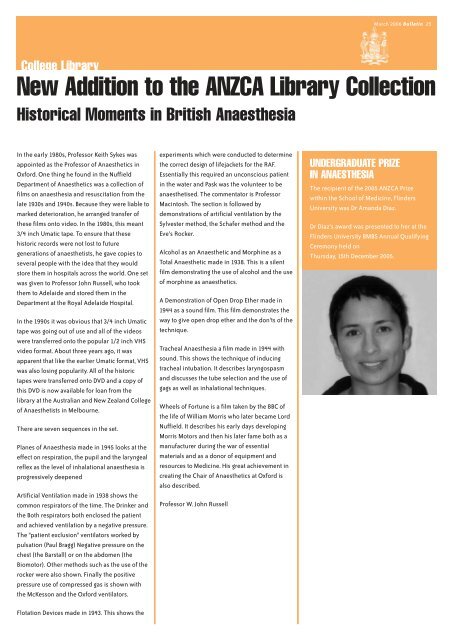ANZCA Bulletin - March 2006 - Australian and New Zealand College ...
ANZCA Bulletin - March 2006 - Australian and New Zealand College ...
ANZCA Bulletin - March 2006 - Australian and New Zealand College ...
Create successful ePaper yourself
Turn your PDF publications into a flip-book with our unique Google optimized e-Paper software.
<strong>March</strong> <strong>2006</strong> <strong>Bulletin</strong> 25<br />
<strong>College</strong> Library<br />
<strong>New</strong> Addition to the <strong>ANZCA</strong> Library Collection<br />
Historical Moments in British Anaesthesia<br />
In the early 1980s, Professor Keith Sykes was<br />
appointed as the Professor of Anaesthetics in<br />
Oxford. One thing he found in the Nuffield<br />
Department of Anaesthetics was a collection of<br />
films on anaesthesia <strong>and</strong> resuscitation from the<br />
late 1930s <strong>and</strong> 1940s. Because they were liable to<br />
marked deterioration, he arranged transfer of<br />
these films onto video. In the 1980s, this meant<br />
3/4 inch Umatic tape. To ensure that these<br />
historic records were not lost to future<br />
generations of anaesthetists, he gave copies to<br />
several people with the idea that they would<br />
store them in hospitals across the world. One set<br />
was given to Professor John Russell, who took<br />
them to Adelaide <strong>and</strong> stored them in the<br />
Department at the Royal Adelaide Hospital.<br />
In the 1990s it was obvious that 3/4 inch Umatic<br />
tape was going out of use <strong>and</strong> all of the videos<br />
were transferred onto the popular 1/2 inch VHS<br />
video format. About three years ago, it was<br />
apparent that like the earlier Umatic format, VHS<br />
was also losing popularity. All of the historic<br />
tapes were transferred onto DVD <strong>and</strong> a copy of<br />
this DVD is now available for loan from the<br />
library at the <strong>Australian</strong> <strong>and</strong> <strong>New</strong> Zeal<strong>and</strong> <strong>College</strong><br />
of Anaesthetists in Melbourne.<br />
There are seven sequences in the set.<br />
Planes of Anaesthesia made in 1945 looks at the<br />
effect on respiration, the pupil <strong>and</strong> the laryngeal<br />
reflex as the level of inhalational anaesthesia is<br />
progressively deepened<br />
Artificial Ventilation made in 1938 shows the<br />
common respirators of the time. The Drinker <strong>and</strong><br />
the Both respirators both enclosed the patient<br />
<strong>and</strong> achieved ventilation by a negative pressure.<br />
The "patient exclusion" ventilators worked by<br />
pulsation (Paul Bragg) Negative pressure on the<br />
chest (the Barstall) or on the abdomen (the<br />
Biomotor). Other methods such as the use of the<br />
rocker were also shown. Finally the positive<br />
pressure use of compressed gas is shown with<br />
the McKesson <strong>and</strong> the Oxford ventilators.<br />
Flotation Devices made in 1943. This shows the<br />
experiments which were conducted to determine<br />
the correct design of lifejackets for the RAF.<br />
Essentially this required an unconscious patient<br />
in the water <strong>and</strong> Pask was the volunteer to be<br />
anaesthetised. The commentator is Professor<br />
Macintosh. The section is followed by<br />
demonstrations of artificial ventilation by the<br />
Sylvester method, the Schafer method <strong>and</strong> the<br />
Eve's Rocker.<br />
Alcohol as an Anaesthetic <strong>and</strong> Morphine as a<br />
Total Anaesthetic made in 1938. This is a silent<br />
film demonstrating the use of alcohol <strong>and</strong> the use<br />
of morphine as anaesthetics.<br />
A Demonstration of Open Drop Ether made in<br />
1944 as a sound film. This film demonstrates the<br />
way to give open drop ether <strong>and</strong> the don'ts of the<br />
technique.<br />
Tracheal Anaesthesia a film made in 1944 with<br />
sound. This shows the technique of inducing<br />
tracheal intubation. It describes laryngospasm<br />
<strong>and</strong> discusses the tube selection <strong>and</strong> the use of<br />
gags as well as inhalational techniques.<br />
Wheels of Fortune is a film taken by the BBC of<br />
the life of William Morris who later became Lord<br />
Nuffield. It describes his early days developing<br />
Morris Motors <strong>and</strong> then his later fame both as a<br />
manufacturer during the war of essential<br />
materials <strong>and</strong> as a donor of equipment <strong>and</strong><br />
resources to Medicine. His great achievement in<br />
creating the Chair of Anaesthetics at Oxford is<br />
also described.<br />
Professor W. John Russell<br />
UNDERGRADUATE PRIZE<br />
IN ANAESTHESIA<br />
The recipient of the 2005 <strong>ANZCA</strong> Prize<br />
within the School of Medicine, Flinders<br />
University was Dr Am<strong>and</strong>a Diaz.<br />
Dr Diaz's award was presented to her at the<br />
Flinders University BMBS Annual Qualifying<br />
Ceremony held on<br />
Thursday, 15th December 2005.

















